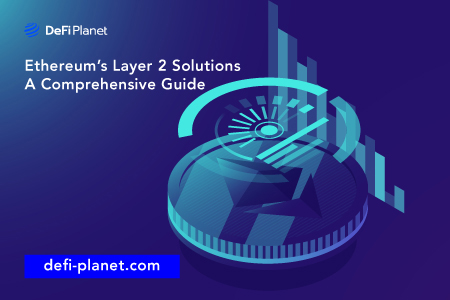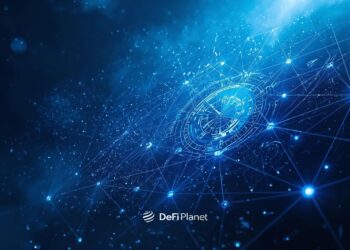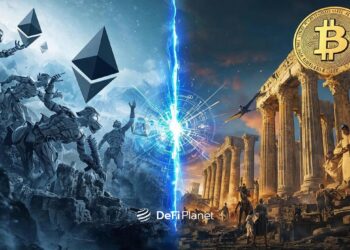Last updated on July 19th, 2023 at 06:13 am
Ethereum is one of the biggest and most popular cryptocurrency projects as the leading blockchain for decentralized applications (dApps) due to its compatibility with smart contracts.
However, its popularity has led to congestion and high gas fees, thus, a poor user experience and massive scalability issues.
The Ethereum Foundation and its developers are actively working on many direct solutions to increase the scalability of the network and solve these challenges.
Ethereum 2.0. is a prominent example of some of the upgrades they have introduced. While this upgrade is a step in the right direction, it is still not fully capable of addressing Ethereum’s scalability issues.
These issues are also being tackled in another way – many projects are trying to build on top of the existing Ethereum network and provide features that enhance its usability.
These solutions are popularly known as Layer 2 solutions and are primarily designed to combat congestion on Ethereum. The result is faster and cheaper transactions, particularly in real-time use cases like spot trading and gaming that require immediate data processing.
Several Ethereum Layer 2 solutions have already gained significant adoption, so much so that some users are unaware that they are on Layer 2 networks.
This article will introduce you to Layer 2 scaling solutions for Ethereum, explore their distinctive characteristics, and highlight some of the best Ethereum Layer 2 scaling projects.
Let’s dive in!
What are Ethereum Layer 2 Solutions?
Layer 2 solutions are protocols built on top of an existing blockchain to improve the efficiency and scalability of the blockchain. Consequently, Ethereum layer 2 solutions are suites of protocols that are designed to improve the scalability of the Ethereum blockchain.

These solutions are built on top of existing Layer 1 blockchains or independently to address scalability issues. In the former, Layer 2 solutions leverage the security of the Layer 1 network while processing transactions off the main chain. In the latter, Layer 2 solutions employ their own consensus mechanisms while maintaining compatibility with Layer 1 to scale the network.
Ethereum Layer 2 solutions offer faster and more cost-effective alternatives to using the Ethereum blockchain, all while maintaining the network’s security. In simpler terms, Ethereum Layer 2 solutions aim to improve the overall user experience of Ethereum.
Why Do We Need Ethereum Layer 2 Solutions?
- Layer 2 solutions improve the scalability of the Ethereum network by offloading a significant portion of transactions and computation from the Ethereum network.
- Layer 2 solutions are a cost-effective option for facilitating microtransactions on the Ethereum network.
- Layer 2 solutions preserve decentralization by maintaining Ethereum’s security while improving Ethereum’s user experience.
- Layer 2 solutions make the Ethereum blockchain fit for applications that require high transaction throughput and real-time interaction. E.g., gaming.
In a nutshell, Layer 2 solutions solve Etheruem’s persisting problems of bad user experience and scalability issues while opening a new world of possibilities on the network.
Types of Ethereum Layer 2 Scaling Solutions
The term ‘Layer 2’ describes a suite of solutions with different operating principles even though they fulfil the same purpose: improving network’s scalability while ensuring a better user experience.
There are three main types of Ethereum Layer 2 solutions.
- Channels,
- Rollups, and
- Plasma.
Figure 1: Types of Ethereum Layer 2 Scaling Solutions

Let’s discuss them in detail.
Channels
Channels are a type of Layer 2 solution on Ethereum that allow users to conduct off-chain transactions directly with each other while benefiting from the security of the Ethereum network.
Channels are particularly well-suited for peer-to-peer transactions that occur over an extended period. With channels, users only need to sign two transactions on-chain: one to initiate the transaction and another to conclude it.
Also, the only fees required are gas fees for these two transactions. All the intermediate transactions within the channel incur no additional costs.
This shift of transaction processing to channels reduces congestion on the Ethereum blockchain; fewer transactions need to be verified on the main chain.
Channels rely on a multisig smart contract to facilitate their operations. This kind of smart contract allows the establishment of predefined rules that ensures that multiple parties (in this case, the parties involved in the transactions) can sign transactions. This also ensures the security and integrity of the transactions.
State Channels and Payment Channels are two popular types of channels.
- State Channels: State channels, as the name suggests, capture and record the final state of a transaction on the Ethereum network. With state channels, users are only required to sign transactions on the Ethereum chain at the start and end of the transaction.
State channels are best suited to developing decentralized applications (dApps) that require real-time data updates. They allow the developer to create several possibilities and conduct several transactions to update their data without incurring hefty expenses. For example, state channels make it feasible to build and play games off-chain and still benefit from the security of the Ethereum network.
- Payment Channels: Payment channels allow two parties to initiate multiple transactions while only requiring two on-chain signatures. The initial and final transactions are the only ones that need to be signed and recorded on the Ethereum blockchain, while the intermediate transactions occur off-chain.
Payment channels are particularly efficient for conducting micropayments on the Ethereum network. To establish a payment channel, the participating parties deposit a certain amount of funds sufficient for the duration of the transaction into a channel. After completing the transactions, the parties sign the final transaction on the Ethereum blockchain.
Though both state channels and payment channels offer accelerated and cost-efficient transaction processing on the Ethereum network, they are primarily suitable for peer-to-peer transactions and do not support batch payments. Examples of channel solutions include Raiden, Connext, and Celer Network.
Rollups
Rollups are Layer 2 solutions designed to reduce the number of transactions processed directly on Ethereum by consolidating multiple transactions into a single batch.
Rollups reduce the need for validators on the Ethereum network to verify every single transaction, which can otherwise lead to network congestion. Consequently, the Ethereum network can handle a higher transaction throughput. In fact, rollups have the potential to increase transaction processing capacity on the Ethereum blockchain by up to 100 times.
Also, rollups offer cost savings on gas fees since multiple transactions are processed as a single unit. An Ethereum rollup protocol only requires a fraction of the fee associated with the batch of transactions in which your transaction is included.
Rollups are classified as hybrid scaling solutions since they execute data processing off-chain while leveraging the Ethereum network for security.
There are two primary types of rollups: Optimistic rollups and zk-rollups. The choice of which one to use depends on developers’ preferences and project requirements.
- Optimistic Rollups: Optimistic rollups are “optimistic” in nature, meaning they are designed to accept and process all transactions initiated on the protocol as valid. Then the processed transactions are then sent to the Ethereum network in batches.
To ensure the validity of these transactions, optimistic rollups include a “challenge period” during which anyone on the network can challenge incorrectly processed transactions. This mechanism provides a fraud-proof function to safeguard the network against malicious actors.
Optimism and Arbitrum are two prominent examples of optimistic rollups Layer 2 solutions.
- Zero-Knowledge Rollups (zk-rollups): Unlike Optimistic rollups, zk-rollups do not assume transactions are valid by default. Instead, they use cryptographic techniques known as Zero-Knowledge Proofs (zk-Proofs) to mathematically validate the authenticity of transactions.
Instead of sending transaction data to the Ethereum chain, zk-rollups send validity proofs to prove that a transaction occurred. Since zk-rollups do not transfer transaction data to the Ethereum network and do not require a “challenge period” for verification, they can process transactions quickly. Additionally, validity proofs occupy less space on the Ethereum network.
zk-rollups offer swifter transaction processing and improved security compared to Optimistic rollups. Emerging blockchain protocols such as Matter Labs’ zkSync and Polygon’s zk-EVM network on the Polygon platform are examples of how zk-rollups.
Plasma
Plasma is a Layer 2 scaling solution introduced by Ethereum co-founder Vitalik Buterin and Joseph Poon in 2017.
Similar to Layer 2 rollups, Plasma operates on its own chain outside of the Ethereum blockchain. It ensures security by periodically committing the final state of transactions to the Ethereum mainnet through a two-way bridge. This allows for parallel transaction processing without overwhelming the Ethereum network.
To scale Ethereum, Plasma employs a hierarchical structure of sidechains called “Plasma chains” or “child chains.” These child chains split the network into smaller parts, allowing parallel transaction processing without congesting the Ethereum network.
Child chains in Plasma function as independent blockchains with their own consensus mechanism, nodes, and block time. Transactions on these chains are validated by a set of operators who bundle them together and commit the final state to the Ethereum mainnet. This enables faster confirmation times and higher throughput for specific use cases like decentralized exchanges, gaming platforms, and payment systems.
Despite its benefits, Plasma does have limitations. Withdrawals from the Ethereum mainnet can be delayed due to the required “challenge period” for transaction validation. Additionally, there are concerns about potential manipulation by malicious operators to withdraw funds from the Ethereum network through fraudulent transactions.
While Plasma has faced challenges in implementation and adoption, it has contributed to the exploration and advancement of scalable solutions for Ethereum.
Are Sidechains Considered Ethereum Layer 2 Solutions?
No, sidechains are not typically classified as Layer 2 scaling solutions for Ethereum. While they are a form of scaling solution, they operate as independent blockchains alongside the Ethereum network.
Figure 2: Anatomy of Sidechains

Sidechains share certain underlying infrastructure with Ethereum and can establish interoperability through bridges. However, they handle transaction processing and verification separately from the Ethereum blockchain.
Although sidechains often offer faster and more cost-effective transactions, they generally lack the same level of network security as the Ethereum network.
Sidechains employ their own consensus mechanisms to secure the network. Popular sidechains like Polygon (formerly Matic) have utilized Proof-of-Stake (PoS) consensus prior to Ethereum’s transition to PoS.
What Are The Best Ethereum Layer 2 Solutions?
Determining the best Layer 2 solution for Ethereum is akin to selecting your favourite flavour at an ice cream shop—it depends on individual needs and requirements. Different solutions excel in various areas and offer unique benefits.
Channels, for example, provide a cost-effective method for processing transactions on the Ethereum network. They allow for millions of transactions within a channel without incurring additional costs until the transaction is closed. However, channels are best suited for peer-to-peer transfers and may not be suitable for all use cases.
Rollups, on the other hand, are widely recognized for their ability to process transactions faster and at a lower cost on Ethereum. They offer scalability benefits and are adaptable to a range of applications. However, there are different types of rollups and different variations currently under development.
Plasma can be a favourable option when building decentralized applications (dApps) that require customized smart contract features tailored to specific use cases. It enables faster confirmation times and higher throughput for certain applications.
Currently, Ethereum does not have an official Layer 2 solution, but the development community is actively exploring different options to enhance scalability. While Sharding was initially considered, the focus has shifted to combining rollups with an alternative Sharding method called Danksharding. This approach aims to increase Ethereum’s transaction processing capacity to up to 100,000 transactions per second (tps).
The Ethereum network prioritizes Layer 2 solutions that maintain the security of Ethereum while achieving scalability. The developers’ ultimate goal is to address the blockchain trilemma, which involves finding a balance between security, scalability, and decentralization. By striking this balance, Ethereum can enhance its overall performance and provide a better user experience.
Ethereum Layer 2 Ecosystem
The Ethereum Layer 2 ecosystem is the collective network of various Layer 2 scaling solutions and projects built on top of the Ethereum blockchain. The ecosystem represents a vibrant and growing community of developers, entrepreneurs, and users working together to overcome the scalability limitations of the Ethereum blockchain and unlock the full potential of decentralized applications and services.
Figure 3: Layer 2 Scaling solutions On Ethereum

Within the Ethereum Layer 2 ecosystem, there are several projects and protocols that provide infrastructure, tools, and services to support the development, deployment, and usage of Layer 2 solutions. Some of these projects include:
- Arbitrum
Arbitrum is a leading provider of Optimistic Rollups, a type of Layer 2 solution that processes transactions off-chain and relies on Ethereum for dispute resolution. They offer infrastructure and developer tools to enable the deployment of Optimistic Rollups.
- Optimism
Optimism is another provider of Optimistic Rollup technology. Their solution enables faster and cheaper transactions while maintaining compatibility with existing Ethereum smart contracts.
- Loopring
Loopring is a protocol for building decentralized exchanges (DEXs) on Ethereum Layer 2. It utilizes zk-rollup technology to achieve high throughput and low fees for trading digital assets.
- StarkNet
StarkNet offers Layer 2 solutions based on zero-knowledge proofs (ZKPs). Their technology enables scalable and privacy-preserving computation, allowing for efficient transaction processing and data validation.
These are just a few examples of projects within the Ethereum Layer 2 ecosystem. The ecosystem is continually evolving, with new innovations, protocols, and collaborations being developed to further enhance the scalability and usability of the Ethereum network.
Ethereum Layer 1 vs Layer 2
Ethereum Layer 1, also known as the Ethereum main chain, is the primary chain of the Ethereum network that we are familiar with. Transactions and gas fees on the Ethereum network are processed using the ETH token.
As we discussed earlier, Layer 2 solutions were introduced to address the challenges stemming from the high demand and limited capacity of the Ethereum main chain, such as congestion and high gas fees. These Layer 2 solutions leverage the security of the Ethereum blockchain while providing faster and more cost-effective transactions, enhancing the overall user experience.
Layer 2 solutions like Arbitrum and zkSync have their own versions of Ethereum’s native token, Ether (ETH), which are used to pay for transactions within their networks. For instance, Arbitrum utilizes AETH as their version of ETH, while zkSync employs zkETH. It’s important to note that the value of these Layer 2 tokens is equivalent to the native Ether (ETH) on the Ethereum network.
While there are similarities, there are also distinctions between Layer 1 and Layer 2 solutions. Some Layer 2 solutions, such as Arbitrum and Optimism, have their own native tokens, primarily utilized for governance purposes within their ecosystems. For example, ARB serves as Arbitrum’s Layer 2 coin.
To better understand the differences between Ethereum Layer 1 and Layer 2 solutions, refer to the table below:
Figure 4: A Comparison of Ethereum Layer 1 and Popular Layer 2 and Other Scaling Solutions

Please note that the information in the table is based on general characteristics stated in the whitepaper and official documentation of these projects.
In Conclusion,
- Until the Ethereum network can scale on its own and meet the demands of its ever-growing user base, Ethereum Layer 2 solutions will continue to experience increased adoption as an alternative for a better user experience on the Ethereum network.
- However, the future of Ethereum Layer 2 solutions in a scenario where Ethereum achieves self-scaling stability remains uncertain. Nonetheless, Layer 2 solutions that offer unique features beyond mere scalability are likely to remain relevant in the long term.
- In recent times, zk-rollups, utilized by projects like zkSync and StarkNet, have gained significant traction as preferred Layer 2 solutions. Prior to rollups, there were other preferred Layer 2 solutions, indicating a dynamic landscape of innovation.
- This suggests that we can expect further advancements in Layer 2 solutions that significantly improve Ethereum’s scalability.
If you would like to read more articles like this, visit DeFi Planet and follow us on Twitter, LinkedIn, Facebook, Instagram, and CoinMarketCap Community.
“Take control of your crypto portfolio with MARKETS PRO, DeFi Planet’s suite of analytics tools.”





















